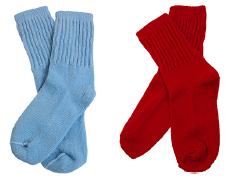This problem solving activity has a statistics focus.

There are two red socks and two blue socks.
Are the boys more likely to get a pair, or one sock of each colour?
How do you know?
- Work systematically to identify all the possible outcomes.
- Describe events using everyday language.
In this problem students should be encouraged to draw combinations, make a systematic list or table, or use equipment to show that they have explored all the possibilities.
The solution shows a systematic approach.
- Copymaster of the problem (English)
- Copymaster of the problem (Māori)
- A pair of red and blue socks to introduce the problem
The Problem
For fun, Iosefa and Maru are dressing in the dark. There are two red socks and two blue socks. Are the boys more likely to get a pair, or one sock of each colour?
How do you know?
Teaching Sequence
- Use the pairs of socks to introduce the problem. Hide the socks in a bag and get students to take turns selecting 2 socks from the bag of 4. After a number of attempts pose the problem.
- Discuss their ideas following from the experiment.
Do you think that it is more likely for the boys to get a pair? Why? - Brainstorm for ways to solve the problem (other than carrying out the experiment). Encourage the students to see that they need to find all the possible ways for the sock to be drawn from the bag.
- As the students work on the problem in pairs or small groups ask them questions that focus on finding all the possible outcomes.
How many different ways can you get socks from the bag?
How do you know that you have found all the ways?
If Iosefa pulls out a pair what happens to Maru? - Share solutions. You might draw the table from the solution with, or for, the class to demonstrate the final solution.
Extension
The next day there are 5 socks to choose from. There are 3 blue socks and 2 red. Are the boys more likely to get odd socks or a pair? Show how you know.
Solution
The table represents Iosefa's choices. After all, if he chooses a pair, then so does Maru. And if Iosefa chooses a mixture, then so does Maru.
You will notice that in the table there are some blank spaces. This is because Iosefa can’t choose the first red sock (R1) and the first red sock (R1). He has to choose two different socks.
| R1 | R2 | B1 | B2 | |
R1 | R1,R2 (pair) | R1,B1 | R1,B2 | |
R2 | R2,R1 (pair) | R2,B1 | R2,B2 | |
B1 | B1,R1 | B1,R2 | B1,B2 (pair) | |
B2 | B2,R1 | B2,R2 | B2,B1 (pair) |
From the table there are 12 possibilities for Iosefa. We have indicated the pairs. There are only 4 possible pairs. This means that Iosefa is more likely to get an ‘odd’ pair than a proper pair.
Solution to the Extension
There is even less chance of the boys getting a pair of socks here. This is because in the extension there are 20 ways of choosing the socks and there are only 8 pairs possible.